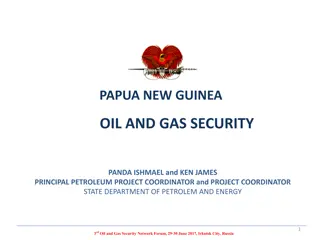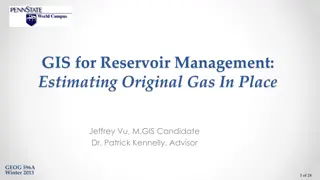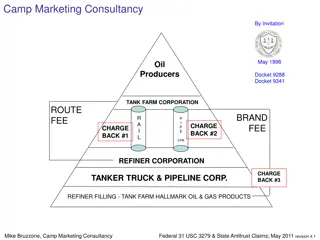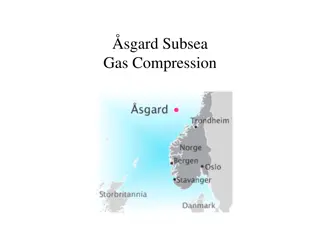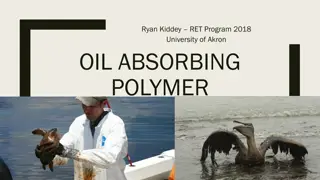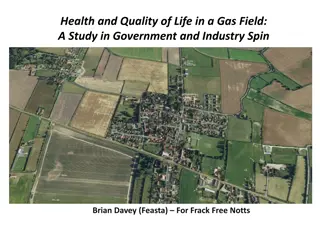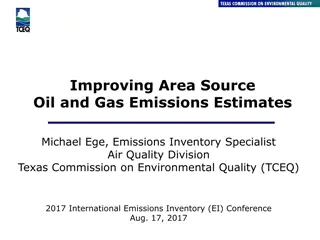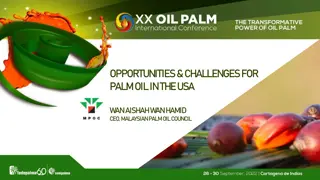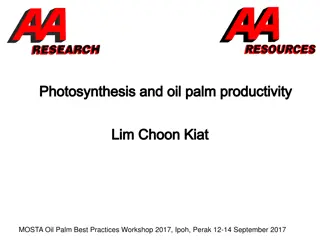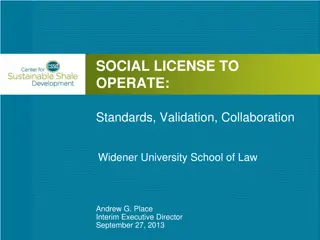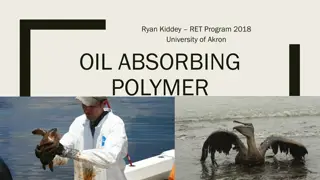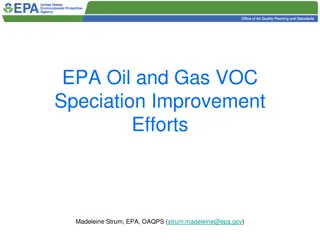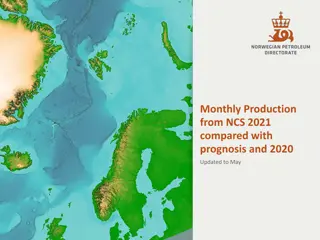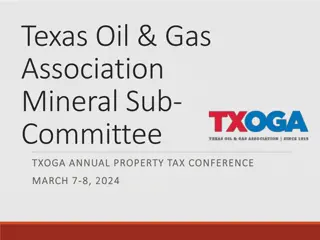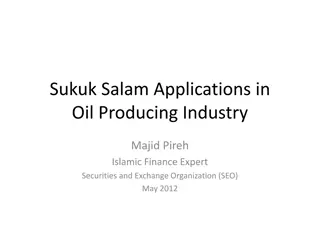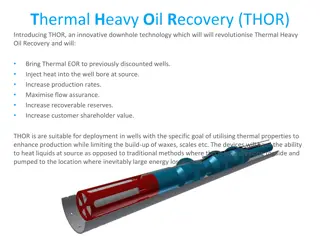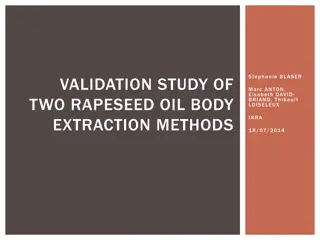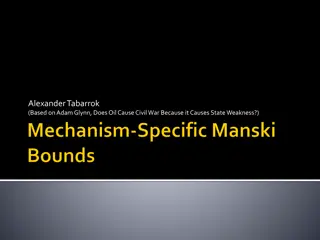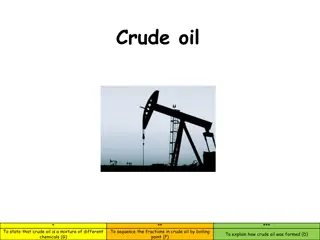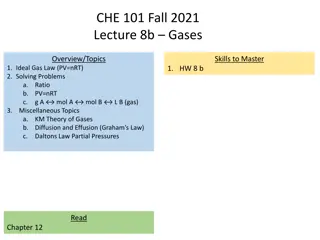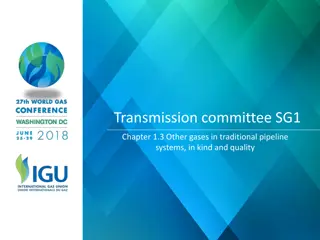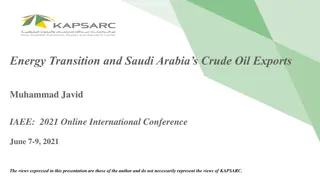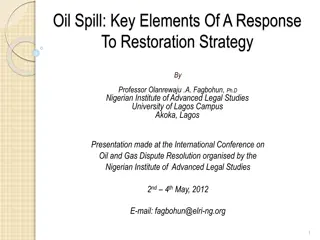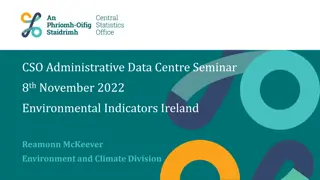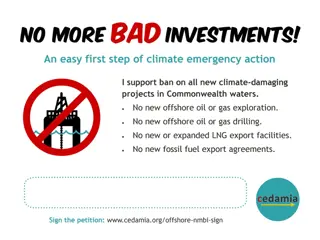Environmental Considerations in U.S. Oil and Gas Industry
This presentation delves into the various environmental considerations within the U.S. oil and gas industry, covering nationwide and regional issues, industry examples, wildlife impacts, best practices, and cultural resources. It emphasizes federal regulations such as the Endangered Species Act and the Migratory Bird Treaty Act, as well as state and local regulations affecting threatened and endangered species. The importance of tools like IPaC for project planning and conservation is also highlighted.
- Oil and Gas Industry
- Environmental Considerations
- Federal Regulations
- Endangered Species
- Wildlife Impacts
Download Presentation

Please find below an Image/Link to download the presentation.
The content on the website is provided AS IS for your information and personal use only. It may not be sold, licensed, or shared on other websites without obtaining consent from the author. Download presentation by click this link. If you encounter any issues during the download, it is possible that the publisher has removed the file from their server.
E N D
Presentation Transcript
Environmental Considerations in Various Plays Within the U.S. Oil and Gas Industry by Peter D. McKone, CWB Weaver Consultants Group
Outline Nationwide Issues Regional Issues Industry Examples General Wildlife Impacts Best Practices Cultural Resources 2
Nationwide Issues Federal Regulation The Endangered Species Act (ESA) Threatened, endangered and candidate species Section 7 consultation Interagency consultation May affect (informal consultation) or likely to adversely affect (formal consultation) Section 10 consultation non-federal applicants Biological assessments and biological opinions Incidental take permits 3
IPaC Information, Planning and Conservation System https://ecos.fws.gov/ipac/ Assist in determining whether threatened and endangered species, designated critical habitat, proposed critical habitat, migratory birds and other natural resources may be affected by project Summarizes distribution of important biological resources such as wetlands, refuges, critical habitat, etc. Get a preliminary or official USFWS species list
Nationwide Issues The Migratory Bird Treaty Act (MBTA) Protects all migratory birds Exceptions include non-native birds such as house sparrows and European starlings Illegal for anyone to take, possess, import, export, transport, sell, purchase, barter, or offer for sale, purchase, or barter, any migratory bird, or the parts, nests, or eggs of such a bird except under the terms of a valid permit issued pursuant to federal regulations Incidental take permits Recent interpretation by President only intentional take covered The Bald and Golden Eagle Protection Act (BGEPA) Provides long-term species management and protection in addition to the ESA and MBTA 5
Regional Issues State and Local Regulation State-level threatened and endangered species regulation States often provide varying degrees of species regulation and/or have few resources for regulatory enforcement Many state-listed species may also be federally listed or federal candidate species 6
Regional Issues (cont.) The Barnett Shale Golden-cheeked warbler, migratory birds The Eagle Ford Shale Texas tortoise, Texas horned lizard, spot- tailed earless lizard The Permian Basin Dunes sagebrush lizard, migratory birds, playa floodplains, public property in the western Permian, lesser prairie-chicken The Bakken Shale Piping plovers, migratory birds, wintering elk, public lands, grassland birds The Haynesville Shale Red-cockaded woodpecker, Louisiana black bear, Louisiana pine snake Oklahoma American burying beetle, public lands, lesser prairie chicken, Arkansas River shiner The Marcellus Shale Mussels, bats 7
Example Dunes sagebrush lizard Permian Basin = 39.6 million acres Dunes sagebrush lizard occupies less than 2% of the basin Effective Conservation Efforts Candidate Conservation Agreements 2012 Texas Conservation Plan Implement construction BMPs Trench length/duration Limit vegetation removal Temporal construction limits HDD Proposal for listing was withdrawn by USFWS in 2012 Frac sand operations have heated up the issue 8
General Wildlife Impacts Habitat loss, degradation, fragmentation Occurs with any development (energy, residential, commercial, industrial, etc.) Cumulative effects of development can lead to reduction in populations Monarch butterflies, mussels Behavioral modifications to populations as a result of more wells, lease roads, etc. Can diminish breeding success Potential significant threats to population viability include avoidance due to increased vehicle traffic, construction of new roads or modification of existing ones, well pads and pipelines Stressors during critical life cycle periods Pronghorn antelope, lesser prairie chickens 9
General Wildlife Impacts (cont.) Impacts to watersheds Mussels, fish Loss of wintering ranges for ungulates in colder climates Deer, elk Loss of specialized habitat for specialists 10
Best Practices Minimize habitat fragmentation by using existing roads and corridors whenever possible. Avoid or protect sensitive areas, seek qualified help identifying these areas, and limit development and disturbance to agreed-upon development corridors. Monitor surface and subsurface water quality. Prevent erosion and contamination of topsoil. Prevent the introduction or spread of invasive and exotic plants. Use only locally adapted native seed when possible to reclaim and re-vegetate sites. Plan operations to minimize impacts to traditional land uses during development. 11
Best Practices (cont.) Open pits Birds and wildlife attracted to pits Close containment systems Deterrents (netting, eliminate pits, keep oil off open pits or ponds) Ineffective Flagging Reflectors Strobe lights Zon guns
National Historic Preservation Act of 1966 National Register of Historic Places State Historic Preservation Officers Advisory Council on Historic Preservation
NHPA (cont.) Federal Undertaking Any project that involves Federal funds Federal permits Federal licenses Federal approval
NHPA Consultation Identify Area of Potential Effect (APE) Identify historic properties (survey and testing) Assess the project s effects on historic properties Consult to resolve adverse effects Allow Advisory Council on Historic Preservation an opportunity to comment
Area of Potential Effect The geographic area or areas within which an undertaking may cause changes in the character or use of historic properties
Questions Peter D. McKone, CWB Weaver Consultants Group pmckone@wcgrp.com


